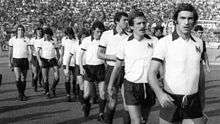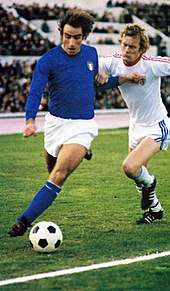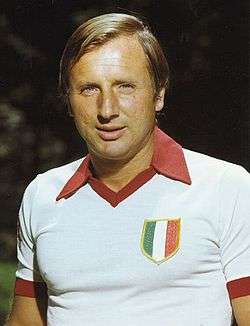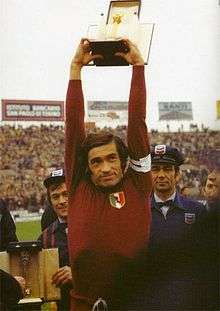Torino F.C.
 | |||
| Full name | Torino Football Club S.p.A | ||
|---|---|---|---|
| Nickname(s) |
Il Toro (The Bull) I Granata (The Maroons) | ||
| Founded |
| ||
| Ground | Stadio Olimpico Grande Torino | ||
| Capacity | 27,958[3] | ||
| Owner | UT Communication | ||
| Chairman | Urbano Cairo | ||
| Head coach | Walter Mazzarri | ||
| League | Serie A | ||
| 2017–18 | Serie A, 9th | ||
| Website | Club website | ||
|
| |||
Torino Football Club (Italian pronunciation: [toˈriːno]), commonly referred to as Torino or simply Toro, is a professional Italian football club based in Turin, Piedmont, that plays in Serie A.
Founded as Foot-Ball Club Torino in 1906, Torino are among the most successful clubs in Italy with seven league titles, including five consecutive league titles at the time of the Grande Torino, widely recognised as one of the strongest teams of the 1940s.[1] That entire team was killed in the 1949 Superga air disaster. They have also won the Coppa Italia five times, the last of which was in the 1992–93 season. Internationally, Torino won the Mitropa Cup in 1991 and were finalists in the UEFA Cup in 1991–92.
Torino plays all of its home games at the Stadio Olimpico Grande Torino (also known as the Stadio Comunale "Vittorio Pozzo" until 2006). The club's colour is maroon, and its symbol is a rampant bull, the traditional symbol of the city of Turin, of which the club's nickname is derived, "Il Toro" (The Bull).
History
The foundation and first steps
In the city of Turin, the game of football arrived at the end of the 19th century, first introduced by the industrial Swiss and English. By 1887, Football & Cricket Club – the oldest Italian football club – had already been founded in the capital of Piedmont, followed in 1889 by Nobili Torino. In 1891 the two clubs merged to form Internazionale Torino, after which Football Club Torinese was founded in 1894.[4][5][6]
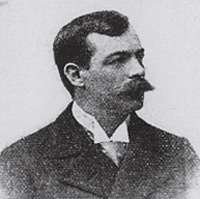
The new game quickly supplanted the popularity of pallapugno, which led to the foundation of the football sections of the sports club Ginnastica Torino and Juventus. On 8 May 1898 Internazionale Torino, Football Club Torinese and Ginnastica Torino, along with Genoa as part of the International Exhibition for the fiftieth anniversary of the Statuto Albertino gave birth to the first Italian Football Championship.
In 1900, Football Club Torinese absorbed Internazionale Torino, but the real turning point for the club arrived on 3 December 1906: at the Voigt brewery (now bar Norman) of Via Pietro Micca, when an alliance was formed with a group of Juventus dissidents, led by the Swiss financier Alfred Dick..[7] Through the merger of Football Club Torinese and the aforementioned group, "Foot-Ball Club Torino" was born. The first official match was played on 16 December 1906 in Vercelli against Pro Vercelli, won 3–1 by Torino.
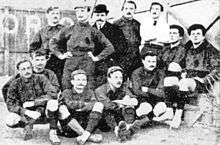
The first derby was played in the new year, dated 13 January 1907, in which Torino defeated Juventus 2–1. Torino successfully replicated this by a margin of 4–1 a month later and gained the right to enter the final round of the Italian Football Championship, placed second behind Milan.
Torino did not participate in the 1908 Italian Football Championship as a rule was passed which limited the use of foreign players. The club instead played in two popular "minor" tournaments: the coveted "Palla Dapples" (a silver trophy in the shape of a regulation football), won against Pro Vercelli; and an international tournament organised by La Stampa, which took place in Turin that year. Torino lost in the final to Swiss side Servette.[8]
In 1915, Torino were denied their first real championship attempt by the outbreak of World War I. With one match left to play, Torino (in second), were two points behind leaders Genoa. In the final game of the championship, Torino would have had the opportunity to play the Genoese head-on after defeating them in the first leg 6–1.
The first scudetto

The club experienced its first success under the presidency of Count Enrico Marone Cinzano, who was responsible for building the Stadio Filadelfia.[9] In attack, Torino boasted the Trio delle meraviglie (Trio of Wonders), composed of Julio Libonatti, Adolfo Baloncieri and Gino Rossetti, and won their first scudetto on 10 July 1927 after a 5–0 win against Bologna. However, the title was revoked on 3 November 1927 due to the "Allemandi Case".[9]
After the revoking of the prior scudetto, Torino were reconfirmed champions of Italy in the 1927–28 season. The "Trio of Wonders" scored 89 goals between them, with the title won on 22 July 1928, a 2–2 draw against Milan.[9]
After the resignation of Cinzano, the club began a slow decline in the early 1930s and often finished mid-table. It was not until the 1935–36 season that it began its revival, with a third place in the league and first victory of the Coppa Italia. Renamed "Associazione Calcio Torino" due to the Italian fascist regime, Torino finished in second place in the 1938–39 season, under the technical director Ernest Erbstein.
In 1939–40, Torino finished fifth place, though it would also see the important arrival of the president Ferruccio Novo. A turning point, Novo would provide financial support to the club and his skill as a careful administrator. With valuable contributions from Antonio Janni, Giacinto Ellena and Mario Sperone, Novo was able to build a team known as the "Grande Torino".[9]
Grande Torino
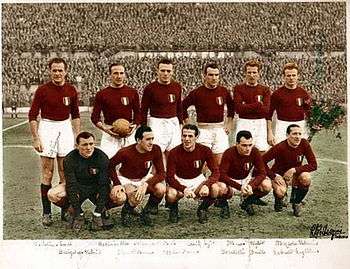
The most shining moment, however, is represented by the Grande Torino, a team which won five titles in a row (not considering the interruption to the league in the 1944 Campionato Alta Italia, in which the Italian Football Federation (FIGC) in 2002 recognised only honorary value to Spezia) between 1942 and 1949, and the Coppa Italia in 1943 (thanks to this success Torino was the first team to win the coveted Scudetto and Coppa Italia "double" in Italy during the same season). Torino was the backbone of the Italian national team in this period, at one point fielding ten players simultaneously in the Azzurri.
The captain and undisputed leader of the team was Valentino Mazzola, father of Ferruccio and Sandro, who then would walk in their father's footsteps by becoming footballers. The typical starting squad was: Bacigalupo; Ballarin, Maroso; Grezar, Rigamonti, Castigliano; Menti, Loik, Gabetto, Mazzola, Ossola. The cycle of victories abruptly ended on 4 May 1949 when the plane carrying the whole team, returning from a friendly with Benfica played in Lisbon, due to a dense fog and a faulty altimeter, crashed against the retaining wall of the Basilica of Superga. In addition to the entire team and reserve players, the Superga air disaster claimed the lives of two executives (Agnisetta and Civalleri), the coaches Egri Erbstein and Leslie Lievesley, the masseur Cortina, three journalists in tow, Luigi Cavallero, Renato Tosatti and Renato Casalbore, and the four members of the crew.
From relegation to the title
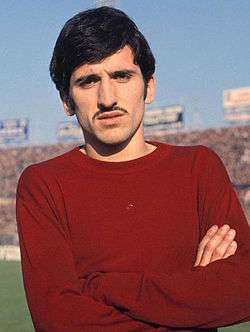
Difficult years followed in the aftermath of the tragedy. A slow decline led to the club's first relegation to Serie B, which took place under the name "Talmone Torino" in 1958–59. The stay in Serie B would only last one season, with Torino's return to the top flight in 1960–61. In 1963, Orfeo Pianelli assumed presidency. He appointed Nereo Rocco as manager and signed club icon Gigi Meroni, nicknamed "The Granata Butterfly."[10] By 1964–65, the team finished in third place.
On 15 October 1967, Meroni was tragically killed while crossing the street after a league game.[11] Despite the tragedy, Torino finished the season in seventh place and won the Coppa Italia. The reconstruction of a winning team, initiated by the President Pianelli, continued with the victory of another Coppa Italia in the 1970–71 season.
In the 1971–72 season, Torino managed second-place finish, placed just one point behind Juventus. Across the following three seasons, Torino would place among the first teams as a prelude to the conquest of what would be their seventh Serie A title.
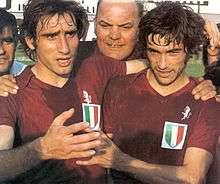
The scudetto was won in the 1975–76 season after a comeback against Juventus, which held a five-point advantage over the Granata during the Spring. However, three straight losses for the Bianconeri, the second of which was in the derby, allowed Torino to overtake. In the final round, Torino held a one point advantage and, until then, was always victorious at home. Torino hosted Cesena at the Comunale: but did not go past a draw; Juventus, however, were defeated at Perugia. The title was won by two points ahead of Juventus, 27 years after the Superga tragedy.
The challenge was repeated the next year in an exciting season that saw Torino finish with 50 points behind Juventus' 51, a record point-total for the 16-team league setup. In 1978, Torino finished second again (tied with a surprising Vicenza side led by Paolo Rossi), still behind Juventus but farther behind in points. In later years, whilst still remaining one of Serie A's top teams, the team began a slow decline and was not able to repeat these results, with the exception of the second place in 1984–85, behind a Verona side led by Osvaldo Bagnoli.
Journey in Europe and bankruptcy

At the end of the 1988–89 season Torino relegated to Serie B for the second time in history.[12] The club was promoted back to Serie A in the 1989–90 season, and after some important signings, qualified for the UEFA Cup under Emiliano Mondonico.[13] The following season, Torino knocked out Real Madrid in the semifinals of the 1991–92 UEFA Cup, but lost the final on the away goals rule to Dutch side Ajax, after a 2–2 draw in Turin and 0–0 in Amsterdam. In Serie A, Torino finished in third place.[14]
In the 1992–93 season, Torino won their fifth Coppa Italia after defeating Roma.[14] However, after the conquest of the Coppa Italia the club went through a period of severe economic difficulties. The club changed presidents and managers several times, but the results continued to worsen; and at the end of the 1995–96 season, Torino relegated for a third time.[15]
After a play-off lost on penalties in the 1997–98 season to Perugia, Torino returned to Serie A in 1998–99, but were once again relegated at the end of the 1999–2000 season.[16] The club was immediately promoted in the 2000–01 season, and the following year, finished in 11th place and qualified for the Intertoto Cup. After being eliminated by Villarreal on penalties, Torino suffered its worst performance in Serie A, and relegated after finishing in last place.[17] Under Renato Zaccarelli, Torino achieved promotion in the 2004–05 season, however, due to heavy debts accumulated under the president Francesco Cimminelli, Torino were denied entry into Serie A and the club's bankruptcy was announced on 9 August 2005.[18] On 16 August, the FIGC accepted the proposal of a new professional entity known as "Società Civile Campo Torino", formed by a group of businessmen and led by lawyer Pierluigi Marengo.[19] The club was granted admission to the Petrucci Law, which guaranteed registration to Serie B, as well as all of the sporting titles of "Torino Calcio." On 19 August, Urbano Cairo was officially announced as the new president of the club at the bar Norman (once known as Voigt brewery).[20] With the sale, the club changed name to "Torino Football Club".
Torino achieved immediate promotion in the 2005–06 season after winning the play-offs. The following season, Torino achieved safety from relegation in the penultimate round of the season. After three seasons, the club once again relegated to Serie B. During the 2009–10 season, Cairo named Gianluca Petrachi as the new sporting director at Torino, but the club failed to gain promotion that season and the following.[21][22]
Return to Europe
On 6 June 2011, the club officially announced Gian Piero Ventura as the new manager ahead of the 2011–12 Serie B season,[23] with Ventura signing a one-year contract.[24] After a long campaign, Torino secured promotion to Serie A on 20 May 2012, after defeating Modena 2–0 in the penultimate round of the season.[25] After achieving safety from relegation in the 2012–13 season, the 2013–14 season marked a sharp reversal for Torino, who finished seventh place, and qualified for the 2014–15 Europa League.[26] The stars of the positive year were Alessio Cerci and Ciro Immobile; the latter, finished as the top scorer in Serie A.[27][28]
The 2014–15 season saw Torino reach the round of 16 of the Europa League, where they were eliminated by Zenit Saint Petersburg. In the league, Torino finished ninth, and in spring, won their first derby in 20 years. The following year, Torino finished the 2015–16 season in 12th place, after which, Ventura, after five years in charge, left the club for the Italy national team. He was replaced by Siniša Mihajlović,[29] who finished the 2016–17 season in ninth place. He was replaced by Walter Mazzarri in January, who closed the 2017–18 season in another ninth place finish.
Colours and badge
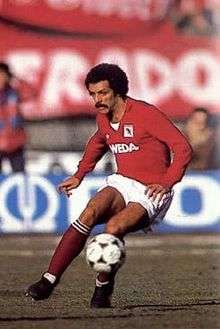
The first uniform used by Torino only a few days after the foundation and the first game of its history against Pro Vercelli was striped orange and black, referring to the kits used by Internazionale Torino and Football Club Torinese, the historical progenitors of the newly born club.[30] Incidentally the colours were too similar to that of the Habsburgs, historical enemies of the then ruling Italian house and considered inappropriate. Given the need to adopt a definitive color the founders opted in the end for granata, a dark red, similar to burgundy.
The most accepted story is that it was adopted in honour of the Duke of the Abruzzi and the House of Savoy, which, after the victorious liberation of Turin from the French in 1706, adopted a blood-colored handkerchief in honour of a messenger killed bringing the news of victory.[31] Other reconstructions, considered less reliable, speak of a tribute to the founder Alfredo Dick, who was a fan of the Genevan team Servette, the Swiss club of the founders homeland, or a reference to the English club Sheffield, the oldest football club in the world, whose colours were also initially adopted by Internazionale Torino. There is even the possibility that the dark red was born by chance, as a result of repeated washing—a reconstruction that is found with many other club's football kits—among the uniforms that were red with black socks; the colour derived, being considered a good omen, would eventually be chosen as the official colour. Previously the Torinese club had instead tried to get the use of royal blue, but the monarchs of Italy were reluctant to grant the use of their dynastic color to a single team, as opposed to what they did, a few years later, with Azure adopted by the various national sports teams.[32][33]
Since then, the traditional home uniform of Torino has been composed of a kit combined with white shorts, or also maroon, and black socks cuffed maroon; However, over the decades it is not unusual to see the team take to the field with maroon socks, especially at the turn of the 1970s and 1980s, permanently adopting a complete maroon kit. The away uniform, usually in reverse colours, provided for a white shirt with contrasting cuffs, maroon, or sometimes also white shorts, with white socks and a maroon lapel.[30][34][35] Cyclically, a recurring away shirt with a diagonal maroon band has also been revived: this is an homage to River Plate, the Argentine club which has close historical ties to Torino since the tragedy of Superga;[36] the shirt was debuted on 6 January 1953 in a league match against Milan, ending 1–1.[37][38]
The Torino club badge has always featured a rampant bull, the symbol of the city of Turin.[39] The current badge was adopted in the 2005–06 season; the first after the bankruptcy of Torino Calcio. The "1906" on the left side of the shield was later added to recall the founding year of the historic Foot-Ball Club Torino.[39]
In the 1980s, the Torino badge was square in shape with a stylised bull and the words "Torino Calcio." This badge is still very much loved by the fans, and in 2013 it was voted by the readers of Guerin Sportivo as the most beautiful club logo of all time.[40] From 1990 until the bankruptcy, the badge in use recalled the one used at the time of the Grande Torino, with the important difference that the right side of the oval crossed the letter "T" and "C" (initials of "Torino Calcio") instead of the letters "A", "C" and "T" (initials of "Associazione Calcio Torino").
In 2017, the Irish club Wexford Youths renamed itself Wexford F.C. and adopted a new crest with rampant bull, inspired by Torino's. Club chairman Mick Wallace is known to be a Torino fan.[41][42][43]
Stadium

The first official match after the foundation, 13 January 1907 (a derby against Juventus), was played at the Stadio Velodrome Umberto. Later, Torino moved to the Piazza d'armi where there were numerous fields: from 23 January, the Lato Ferrovia, and from 26 February 1911, the Lato Crocetta. Towards the end of 1913 the club moved to the Stradale Stupinigi, located in an area of Turin that would not be far from the rising Filadelfia; with the outbreak of the First World War, the stadium was requisitioned for military purposes.[1]
On 11 October 1925, and for the duration of 1925–26, Torino played their home games at Motovelodromo Corso Casale (restored, today it is dedicated to Fausto Coppi and also holds American football matches), while awaiting transfer to the Stadio Filadelfia.[44] The "Fila" is the stadium inextricably linked to the exploits of the Grande Torino: opened on 17 October 1926 against Fortitudo Roma, it hosted Torino's games continuously until 11 May 1958 (the match Torino – Genoa 4–2).[1] In the 1958–59 season, the club briefly moved to the Stadio Comunale: the move was short-lived however, as the club fell to Serie B that year, and superstitiously returned to the Filadelfia.[45]
Torino played the entirety of the 1959–60 season and the next, again in Serie A, at the Filadelfia, but in 1961–62 and 1962–63 began to use the Comunale for "special" matches. The move to the "Comunale," a stadium capable of holding 65,000 people standing, was completed in 1963–64, and lasted until 27 May 1990 when the stadium was abandoned in favour of the Stadio delle Alpi.
At the Stadio Delle Alpi, built specifically for the 1990 FIFA World Cup, Torino played from 1990 to 2006.[45] Following the reconstruction carried out to make the stadium suitable to host the 2006 Winter Olympics opening ceremony and closing ceremony, Torino returned to the former Stadio Comunale, renamed the Stadio Olimpico: the capacity is now 27,958 seated, reduced by about 38,000 seats compared to the original, in compliance with modern, more demanding safety standards.[45] In April 2016, the Olimpico was renamed in honour of the Grande Torino.[3][46]
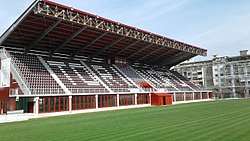
The Stadio Filadelfia was also the training ground of Torino from 1926 to 1993. More recently, from 2006 to 2017, the headquarters of the team's training sessions was the Sisport di Corso Unione Sovietica.[47] In the 2017–18 season, Torino returned to training in the reborn Filadelfia.[48]
Players
Current squad
- As of 31 August 2018.[49]
Note: Flags indicate national team as defined under FIFA eligibility rules. Players may hold more than one non-FIFA nationality.
|
|
Out on loan
Note: Flags indicate national team as defined under FIFA eligibility rules. Players may hold more than one non-FIFA nationality.
|
|
Notable players
- FIFA World Cup winners

- UEFA European Championship winners


Torino and the Italian national team
Among the players of Torino to win titles with the Italian national team are Adolfo Baloncieri, Antonio Janni, Julio Libonatti and Gino Rossetti, all winners with Italy at the Central European International Cup 1927–30, which (with exception of Libonatti) won the bronze medal at the 1928 Summer Olympics.[50][51][52][53] Subsequently, Lido Vieri and Giorgio Ferrini conquered the 1968 European Championship with the Azzurri,[54][55] while Giuseppe Dossena won the FIFA World Cup in 1982.[56]
On 11 May 1947, during a friendly match between Italy and Hungary that finished 3–2, Vittorio Pozzo fielded 10 players that were part of Torino; this is still the match of the Italian national team with the highest number of players coming from the same team.[57]
With 74 players who have represented Italy, Torino is the fifth club for number of players capped by the Azzurri (sixth by number of total admissions).[58] Francesco Graziani is the Torino player who has collected the most appearances (47) and goals (20) for Italy.[57] On 11 June 2017, Andrea Belotti scored the hundredth goal of a Torino player the Azzurri shirt, during a 2018 FIFA World Cup qualification match against Liechtenstein.[59]
Youth system
.jpg)
The Torino youth system is formed by four men's teams that participate in separate national leagues (Primavera, Beretti, Allievi Nazionali Serie A & B, and Allievi Nazionali Lega Pro) and three that participate at a regional level (Giovanissimi Nazionali, Giovanissimi Regionali A & B).[60] Torino was one of the first Italian clubs to adopt a youth system, organised as early as the 1930s and is considered one of the best in Italy.[61]
Domestically, Torino hold the record for most championships won in both the Campionato Nazionale Primavera with nine titles, and the Campionato Nazionale Dante Berretti with 10 titles. In addition, they have won the Coppa Italia Primavera a record eight times, and the prestigious Torneo di Viareggio six times.
The players trained in the Torino youth system were nicknamed "Balon-Boys" in honour of Adolfo Baloncieri, the player and club symbol who ended his career in those years.[62] The Torino youth system has developed numerous players, including actor and journalist Raf Vallone, who devoted himself to a career in the arts after his debut for the first team.[63]
Non-playing staff
Board of directors
| Position | Name |
|---|---|
| President | |
| Vice-president | |
| Director-general | |
| Sporting director | |
| Team manager |
Staff
| Position | Name |
|---|---|
| Manager | |
| Assistant manager | |
| Fitness coaches | |
| Goalkeeping coach | |
| Team manager |
Notable managers
| Name | From | To | Honours |
|---|---|---|---|
| 1926 | 1927 | 1926–27 Divisione Nazionale[66] | |
| 1927 1934 |
1929 1936 |
1927–28 Divisione Nazionale, 1935–36 Coppa Italia | |
| 1942 | 1943 | 1942–43 Serie A, 1942–43 Coppa Italia | |
| 1945 | 1947 | 1945–46 Serie A, 1946–47 Serie A | |
| 1947 | 1948 | 1947–48 Serie A | |
| 1948 | 1949 | 1948–49 Serie A | |
| 1967 | 1969 | 1967–68 Coppa Italia | |
| 1969 | 1971 | 1970–71 Coppa Italia | |
| 1971 | 1974 | ||
| 1975 1984 |
1980 1989 |
1975–76 Serie A | |
| 1990 1998 |
1994 2000 |
1992–93 Coppa Italia, 1990–91 Mitropa Cup |
Supporters and rivalries
The fans of Torino hold a number of distinctions, including the first ever organised supporters group in Italy, the Fedelissimi Granata, founded in 1951.[67] The fans also exhibited the first banner of an organised club, at the Stadio Filadelfia, and organised the first away trip by plane in Italian football, in 1963, during a game against Roma.[67] It was at the Filadelfia that Oreste Bolmida, the famous trumpeter fan, made famous by the film Ora e per sempre, also performed.[68] In the 1970s the fans began to organise the club's first choreographies, which were curiously used in commercials of French carmaker Renault in the next decade.[67] In 1979, the curva Maratona was awarded "the most beautiful stand of Europe" by French magazine Onze Mondial; an image of this section of the stadium was later featured on the cover of France Football on 21 December.[67]
The fans of Torino are "twinned" with the fans of Fiorentina. The link between the two sides was born in the early 1970s to a common anti-Juventus sentiment and the closeness of the Viola after the Superga tragedy.[69] Supporters of Turin are on good terms with the curva nord of Alessandria and curva sud of Nocerina.[70]
The friendship between Brazilian club Corinthians and Torino dates back to 1914; that year, Torino became the first Italian club to land in South America on tour. The club played six friendly matches, two of which were against Corinthians, and despite the results on the field, the two clubs grew and established friendly relations. On 4 May 1949, when the Grande Torino perished in plane crash of Superga, Corinthians paid tribute to the Italians in a friendly match against Portuguesa when its starting XI took to the field in Torino's kit.[71]
The Argentines of River Plate are historically twinned with Torino, since the time of the tragedy of Superga. In the period following the disaster, the Argentine club was very close to the Italian club, organising a friendly and fundraiser to help the devastated team; on 26 May 1949, River flew to Turin to play a friendly charity match, organised by the FIGC, together with a selection that included the strongest Italian players of the era, gathered under the name of "Torino symbol."[72] As a testimony to the relationship between the two clubs, on several occasions the away jersey of the Argentine club was maroon (most recently, the 2005–06 season) while Torino have sported several variations of an away kit with a diagonal band, an homage to River's home kit.[36] Other supporters with whom there is a friendship are supporters of English club Manchester City.[73]
Torino's historical rivalries are with Sampdoria, Piacenza, Verona, Lazio, Perugia, Internazionale, Atalanta, Ternana and Ancona.[74] Torino's friendship with Genoa turned negative as a result of Genoese festivities during the Torino–Genoa match on 24 May 2009 won by the Rossoblu; the result contributed to Torino's relegation to Serie B.[75] On 16 December 2012, the day when the two clubs met for the first time after Torino's return to Serie A, clashes erupted between the two club's organised supporters.[76] The rivalry with city rivals Juventus is the most heartfelt, with the two teams giving life to the so-called Derby della Mole, one of the most popular derbies in Italian football and the oldest still played.
Honours
Domestic
League
Cups
- Runners-up (1): 1993
European
- Winners (1): 1990–91
- Runners-up (1): 1991–92
Others
- Torneo Internazionale Stampa Sportiva:
- Runners-up (1): 1908
- Anglo-Italian League Cup
- Runners-up (1): 1971
Friendly
- Winners (1): 2016–2017
- Amsterdam Tournament:
- Runners-up (1): 1987
- Torneo Interfederale Coppa Torino:
- Runners-up (1): 1910
Notes:
^1 Torino won the title in the 1926–27 season, but it was later revoked.
Statistics and records
Torino is in 8th place in the Serie A perpetual standings,[77] which takes account of all the football teams that have played in the top flight at least once.
In the Italian league, the team has finished in first place on eight occasions, although the club has only won seven championship titles,[78] seven times in second place and nine times in third place.[1] In 100 seasons, including 18 in various championships that preluded the single round format (Torino withdrew in 1908 and the 1915–16 Coppa Federale is not recognised), 73 in Serie A and 12 in Serie B, the club has finished on podium in 23% of cases.[1]
In the 2006–07 season, Torino, for the first time in history played in a category higher than Juventus played: while the Granata competed in Serie A, Juventus took part in Serie B following the aftermath of the Calciopoli scandal.[1]
Giorgio Ferrini holds the club's official appearance record with 566 appearances (plus 56 goals) put together between 1959 and 1975.[79] The record for the most goals scored is held by Paolo Pulici, with 172 official goals (in 437 appearances) between 1967 and 1982.[80]
|
|
Among the top goalscorers, eight different Torino players have won the Capocannoniere award for league topscorer in the Italian top flight: the first was the Austrian Heinrich Schönfeld with 22 goals in 1923–24.[81] He was followed by the Italian Argentine Julio Libonatti, who scored 35 goals in 1927–28 and Gino Rossetti (36) in 1928–29.[81] Rossetti's tally of 36 goals is still the most goals ever scored to win the award. Eusebio Castigliano was the leading scorer (13) of the first 1945–46 season after the Second World War,[81] followed by Valentino Mazzola in 1946–47 (29).[81] Torino would have to wait almost 30 years before another league top scorer emerged: when Paolo Pulici broke the long fast in the mid-1970s and won the award in 1972–73 (17), 1974–75 (18) and 1975–76 (21).[81] He was succeeded by teammate Francesco Graziani in 1976–77, who scored 21 goals. After almost 40 years, Ciro Immobile (22) established himself as the league top scorer in 2013–14.[81]
Kit manufacturers and shirt sponsors
| Years | Kit manufacturer | Sponsors | |
|---|---|---|---|
| 1990–1991 | ABM | Indesit | |
| 1991–1993 | Beretta | ||
| 1993–1994 | Lotto | ||
| 1994–1995 | Bongioanni | ||
| 1995–1996 | SDA Courier | ||
| 1996–2000 | Kelme | ||
| 2000–2001 | Directa | ||
| 2001–2002 | ASICS | Conto Arancio | |
| 2002–2003 | Ixfin | ||
| 2003–2005 | Bavaria | ||
| 2005–2008 | Reale Mutua | Beretta | |
| 2008–2009 | Kappa | Renault Trucks | |
| 2009–2011 | Italporte | Dahlia TV | |
| 2011–2012 | Valmora | Aruba | |
| 2012–2013 | Beretta | ||
| 2013–2015 | Suzuki[82] | ||
| 2015–2017 | |||
| 2017- | SportPesa | ||
See also
References
- 1 2 3 4 5 6 7 "La storia del Torino FC". torinofc.it/. Torino Football Club. Retrieved 12 January 2014.
- ↑ "Torino, finalmente l' accordo a Cairo va la maggioranza". repubblica.it. La Repubblica. Retrieved 1 May 2014.
- 1 2 "Archived copy" (PDF). Archived from the original (PDF) on 1 September 2015. Retrieved 8 April 2017.
- ↑ "Layout 1" (PDF). Retrieved 2017-05-06.
- ↑ "1906 - la nascita del Torino Football Club". Faccedatoro.altervista.org. Retrieved 2017-05-06.
- ↑ "Archived copy". Archived from the original on 5 July 2013. Retrieved 20 May 2013.
- ↑ "Edoardo Bosio and Football in Turin". Life in Italy. Retrieved August 2007. Check date values in:
|accessdate=(help) - ↑ RSSSF. "Torneo Internazionale Stampa Sportiva 1908 (Torino)". Retrieved 20 June 2007.
- 1 2 3 4 "La Storia del Torino Fc". torinofc.it. Torino Football Club. Retrieved 5 November 2014.
- ↑ "Quarantotto anni fa moriva Gigi Meroni, la Farfalla granata".
- ↑ "Torino, 48 anni fa moriva Gigi Meroni. Un video per ricordare il mito granata".
- ↑ Colombero, Pacifico, Agenda Granata 2, pp. 204–206
- ↑ Colombero, Pacifico, Agenda Granata 2, pp. 208–209
- 1 2 Bernardi. Toro. 18.
- ↑ Colombero, Pacifico, Agenda Granata 2, pp. 218–219
- ↑ Colombero, Pacifico, Agenda Granata 2, p. 222
- ↑ Bourne, Peter (2009-09-18). Passion in the Piazza. Lulu.com. p. 45. ISBN 978-1-4116-8181-1. Retrieved 20 June 2014.
- ↑ Bourne, Peter (2009-09-18). Passion in the Piazza. Lulu.com. p. 49. ISBN 978-1-4116-8181-1. Retrieved 20 June 2014.
- ↑ Ormezzano, Gian Paolo. Assolutamente Toro. Turin: Diemme. ISBN 978-8889370087.
- ↑ "Ufficiale, Marengo e Rodda lasciano a Cairo - Toro News". 19 August 2005.
- ↑ "Archivio Toro". www.archiviotoro.it.
- ↑ "Serie B, Torino fuori dai playoff - Calcio - Sportmediaset". Sportmediaset.it.
- ↑ "Il Toro sceglie Ventura, è lui il nuovo mister". Torino.Repubblica.it. 6 June 2011. Retrieved 1 August 2013.
- ↑ "Ventura ha firmato, accordo per una sola stagione". ToroNews.net. 6 June 2011. Retrieved 2 September 2011.
- ↑ "Divertimento, dialogo e zero ansieToro, la rivoluzione di mister libidine".
- ↑ Torino finished seventh in the 2013–14 Serie A and obtained the qualification to the 2014–15 Europe League at the expense of Parma, sixth, but excluded from European competitions due to their failure to obtain a UEFA license for economic reasons, see. Maurizio Galdi (29 May 2014). "Respinto il ricorso del Parma. Torino in Europa League. Ghirardi: "Calcio finito"". gazzetta.it.
- ↑ "MARCATORI – Immobile capocannoniere. Higuain quarto, Callejon sesto". tuttomercatoweb.com (in Italian). Retrieved 20 May 2014.
- ↑ "Cerci uomo-assist del 2013–14, batte tutti i record". corrieredellosport.it (in Italian). Archived from the original on 20 May 2014. Retrieved 20 May 2014.
- ↑ Tom Webber. "Torino: Sinisa Mihajlovic replaces Giampiero Ventura". Goal.com. Retrieved 2017-05-06.
- 1 2 Welter (2013). p. 188. Missing or empty
|title=(help) - ↑ "Il Toro compie 107 anni". buongiornobrasile.com (in Italian). Retrieved 2 May 2014.
- ↑ Savorelli, Sergio Salvi, Alessandro; Alessandro Savorelli (2008). Tutti i colori del calcio : storia e araldica di una magnifica ossessione (in Italian) (5. rist. ed.). Firenze: Le lettere. ISBN 88-6087-178-6.
- ↑ "Torino". uefa.com. Retrieved 31 January 2014.
- ↑ "TORINO FOOTBALL CLUB 1906". tcsecologranata.it (in Italian). Retrieved 1 May 2014.
- ↑ "Presentate a Bormio le maglie del Torino 2013–2014 firmate Kappa". Passionemaglie.it (in Italian). Retrieved 31 January 2014.
- 1 2 "La nuova maglia da trasferta del Torino omaggia il River Plate". Passionemaglie.it. Retrieved 2017-05-06.
- ↑ "River Plate y Torino, unidos en la historia". taringa.net (in Spanish). Retrieved 1 May 2014.
- ↑ "dramma river-plate piange anche il torino". sport.notizie.it (in Italian). Retrieved 31 January 2014.
- 1 2 "TOROshirts - La Storia della Maglia Granata". Toroshirts.it. Retrieved 2017-05-06.
- ↑ "I migliori marchi delle società di calcio". brand-identikit.it (in Italian). Guerin Sportivo. Retrieved 11 April 2014.
- ↑ Byrne, Cormac (3 February 2017). "League of Ireland club reveal new crest and it's very like someone else's".
- ↑ Duffy, Emma. "Change at Wexford FC as they drop the 'Youths' and unveil new club crest".
- ↑ "Wexford FC's new crest looks a lot like an Italian club's crest - SportsJOE.ie".
- ↑ "Storia". motovelodromo.com. Retrieved 13 December 2014.
- 1 2 3 "Lo stadio". torinofc.it. Retrieved 13 December 2014.
- ↑ "Torino stadium renamed". Football Italia. 2016-04-24. Retrieved 2017-05-06.
- ↑ https://www.gazzetta.it/speciali/risultati_classifiche/calcio/squadre/squadra_torino.shtml
- ↑ http://www.toro.it/toro/filadelfia/filadelfia-live-linaugurazione-del-tempio-granata/212417/
- ↑ "Prima Squadra Serie A Tim 2017–2018". torinofc.it. Torino Football Club. Retrieved 27 August 2017.
- ↑ "Nazionale in cifre". FIGC. Retrieved 12 December 2014.
- ↑ "Nazionale in cifre". FIGC. Retrieved 12 December 2014.
- ↑ "Nazionale in cifre". FIGC. Retrieved 12 December 2014.
- ↑ "Nazionale in cifre". FIGC. Retrieved 12 December 2014.
- ↑ "Nazionale in cifre". FIGC. Retrieved 12 December 2014.
- ↑ "Nazionale in cifre". FIGC. Retrieved 12 December 2014.
- ↑ "Nazionale in cifre". FIGC. Retrieved 12 December 2014.
- 1 2 Colombero, Pacifico, Agenda Granata 2, p. 273
- ↑ "Quali squadre hanno 'fornito' più giocatori all'Italia?". 22 June 2017.
- ↑ "Torino, Belotti nella storia: suo il 100° gol di un granata in Nazionale". 12 June 2017.
- ↑ "Settore Giovanile". torinofc.it. Retrieved 12 December 2014.
- ↑ Corrado Zunino (7 May 2009). "La nazionale degli esordienti arrivano i nuovi campioni". la Repubblica. Retrieved 8 April 2012.
- ↑ "1929–1949: il Grande Torino". torinofc.it. Retrieved 12 December 2014.
- ↑ "Raf Vallone". cinematografo.it. Retrieved 12 December 2014.
- ↑ "Allenatore". torinofc.it. Torino Football Club. Retrieved 5 July 2016.
- ↑ "Organizzazione". torinofc.it (in Italian). Torino Football Club. Retrieved 2 May 2014.
- ↑ Revoked because of the Allemandi scandal
- 1 2 3 4 "I primati della tifoseria granata". cellulagranata. 27 November 2012. Retrieved 27 September 2015.
- ↑ "La carica del Filadelfia". calcioromantico.com. 18 April 2014. Retrieved 27 September 2015.
- ↑ "Gemellaggi e rivalità". Viola Ultras. Retrieved 13 October 2010.
- ↑ "Torino e Nocerina, si rinnova l'amicizia tra le due tifoserie". forzanocerina.it.
- ↑ "O INESQUECÍVEL TORINO". citadini.com.br (in Portuguese). citadini. Retrieved 1 February 2014.
- ↑ "Dramma River Plate: piange anche il Torino - Notizie.it". Sport.notizie.it. 2011-06-27. Retrieved 2017-05-06.
- ↑ "Presentate a Bormio le maglie del Torino 2013–2014 firmate Kappa". passionameglie.it. 22 July 2013. Retrieved 19 January 2015.
- ↑ "Torino". rangers.it. Archived from the original on 1 January 2006. Retrieved 14 December 2014.
- ↑ "Genoa, la triste fine di un gemellaggio storico". cittadigenova.com.
- ↑ "Genoa: oltre 400 tifosi in corteo". Corriere dello Sport. Archived from the original on 29 November 2014. Retrieved 14 December 2014.
- ↑ "Classifica perpetua della Serie A - Italia1910.com - Nazionale Italiana di calcio e Serie A". Italia1910.com. Retrieved 2017-05-06.
- ↑ Torino, in fact, finished first in the league of the 1926–27 season, but the resulting title was later withdrawn following the Allemandi scandal. The final position in the standings and all results related to it, however, remained unchanged.
- ↑ "Ferrini Giorgio". Enciclopediadelcalcio.it. 1939-08-18. Retrieved 2017-05-06.
- ↑ "Archived copy". Archived from the original on 22 December 2014. Retrieved 1 January 2015.
- 1 2 3 4 5 6 "Albo classifica marcatori serie A". rosanerouniverse.it (in Italian). Retrieved 1 January 2015.
- ↑ "Suzuki è Official Sponsor del Torino Football Club - Motociclismo". Motociclismo.it. 2013-08-24. Retrieved 2017-05-06.
External links
- (in Italian) (in English) Torino FC Official website
